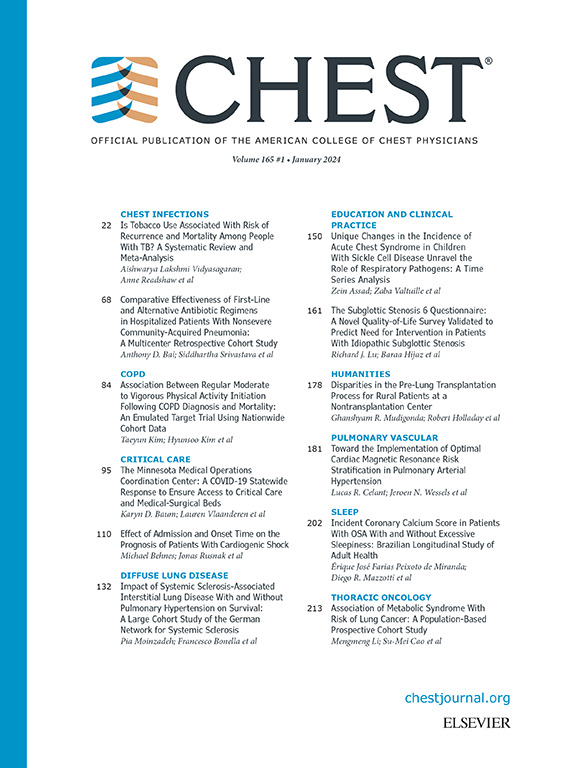肺部定量计算机断层扫描纹理与慢性阻塞性肺病的全身性炎症和死亡率相关。
IF 9.5
1区 医学
Q1 CRITICAL CARE MEDICINE
引用次数: 0
摘要
背景:慢性阻塞性肺疾病(COPD)的特点是持续炎症,导致支气管血管束重塑,这可能导致生活质量下降。定量计算机断层扫描(QCT)肺的纹理可以捕获局部疾病的炎症和相关的呼吸道疾病的模式。研究问题:从适应性多特征法(AMFM)获得的支气管维管束结构与慢性阻塞性肺病的全身炎症、发病率和死亡率有关吗?研究设计和方法我们分析了来自SPIROMICS (n = 2981)和COPDGene (n = 10305)研究的数据。预测指标包括两个QCT生物标志物,支气管维管束(BVB)和CT密度梯度(CTDG)质地、年龄、性别、BMI、种族、吸烟状况、吸烟包年、CT肺气肿和Pi10(气道壁厚度)。结果包括Meso Scale Discovery蛋白质组学测定的血浆生物标志物浓度和全血细胞计数,两者都是炎症标志物,以及FEV1, FEV1/FVC比率,SGRQ, 6MWD和mMRC呼吸困难量表。这些QCT结构与FEV1下降和全因死亡率的关系也被调查。结果BVB织质增加与中性粒细胞和单核细胞计数以及中性粒细胞与淋巴细胞比值(NLR)升高显著相关,独立于临床协变量、CT肺气肿和Pi10。CTDG升高与中性粒细胞计数、NLR和肿瘤坏死因子(TNF)-α升高有关。CTDG和BVB纹理的增加也与较低的FEV1和6分钟步行距离有关。基线时的CTDG也与COPDGene 5年随访时的FEV1下降有关。我们观察到两者之间存在显著相关性(HRSPIROMICS=1.084, 95% CI: 1.035, 1.135, P<0.001;HRCOPDGene=1.106, 95% CI: 1.080, 1.131, P<0.001)和CTDG (HRSPIROMICS=1.033, 95% CI: 1.003, 1.064, P=0.03;HRCOPDGene=1.079, 95% CI: 1.061, 1.096, P<0.001),其全因死亡率与CT肺气肿和Pi10无关。qct结构可能为COPD患者肺部炎症和总体疾病负担的空间异质性提供影像学证据。本文章由计算机程序翻译,如有差异,请以英文原文为准。
Lung Quantitative Computed Tomography Textures are Associated with Systemic Inflammation and Mortality in COPD.
BACKGROUND
Chronic obstructive pulmonary disease (COPD) is characterized by persistent inflammation that is responsible for remodeling the bronchovascular bundles, which may lead to poor quality of life. Quantitative computed tomography (QCT) textures of the lung can capture local disease patterns of inflammation and related respiratory morbidity.
RESEARCH QUESTION
Are bronchovascular bundle textures, obtained from the adaptive multiple feature method (AMFM), associated with systemic inflammation, morbidity, and mortality in COPD?
STUDY DESIGN AND METHODS
We analyzed data from the SPIROMICS (n = 2,981) and COPDGene (n = 10,305) studies. The predictors included two QCT biomarkers, the bronchovascular bundles (BVB) and CT density gradient (CTDG) textures, age, sex, BMI, race, smoking status, smoking pack-years, CT emphysema, and Pi10 (airway wall thickness). Outcomes included plasma biomarker concentrations from Meso Scale Discovery proteomics assays and complete blood counts, both as markers of inflammation, along with FEV1, FEV1/FVC ratio, SGRQ, 6MWD, and mMRC dyspnea scale. Associations of these QCT textures with FEV1 decline and all-cause mortality were also investigated.
RESULTS
Increased BVB texture was significantly associated with elevated neutrophil and monocyte counts, and the neutrophil-to-lymphocyte ratio (NLR), independent of clinical covariates, CT emphysema, and Pi10. Elevated CTDG was associated with increased neutrophil count, NLR, and tumor necrosis factor (TNF)-α. Increased CTDG and BVB textures were also associated with a lower FEV1 and six-minute walk distance. CTDG at baseline was also associated with decline in FEV1 at five-year follow-up in COPDGene. We observed a significant association of both BVB (HRSPIROMICS=1.084, 95% CI: 1.035, 1.135, P<0.001; HRCOPDGene=1.106, 95% CI: 1.080, 1.131, P<0.001) and CTDG (HRSPIROMICS=1.033, 95% CI: 1.003, 1.064, P=0.03; HRCOPDGene=1.079, 95% CI: 1.061, 1.096, P<0.001) textures with all-cause mortality independent of CT emphysema and Pi10.
INTERPRETATION
QCT textures may provide imaging evidence of the spatial heterogeneity of lung inflammation and overall disease burden in COPD.
求助全文
通过发布文献求助,成功后即可免费获取论文全文。
去求助
来源期刊

Chest
医学-呼吸系统
CiteScore
13.70
自引率
3.10%
发文量
3369
审稿时长
15 days
期刊介绍:
At CHEST, our mission is to revolutionize patient care through the collaboration of multidisciplinary clinicians in the fields of pulmonary, critical care, and sleep medicine. We achieve this by publishing cutting-edge clinical research that addresses current challenges and brings forth future advancements. To enhance understanding in a rapidly evolving field, CHEST also features review articles, commentaries, and facilitates discussions on emerging controversies. We place great emphasis on scientific rigor, employing a rigorous peer review process, and ensuring all accepted content is published online within two weeks.
 求助内容:
求助内容: 应助结果提醒方式:
应助结果提醒方式:


